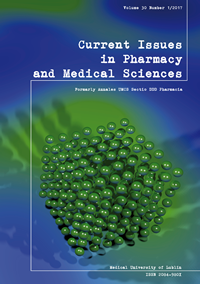Risk of peritoneal dissemination in stomach cancer
DOI:
https://doi.org/10.1515/cipms-2017-0034Keywords:
gastric cancer, peritoneal dissemination, biomarkers, risk profile, immunohistochemistryAbstract
With regard to gastric cancer, an important disease and a public health problem, it is expected that understanding the molecular make up of carcinomas will provide us with more precise targets for therapy. Indeed advanced molecular technology has made it possible to classify according to genotype instead of phenotype. For advanced stomach cancer, however, surgery is still the only option for cure. Yet, also after surgery, more than 50% of the patients will die of peritoneal dissemination of their disease. This review looks at the molecular mechanism of peritoneal spread of stomach cancer in order to arrive at a risk profile that enables medical personnel to raise the index of suspicion for peritoneal carcinomatosis. The peritoneal cancer index (PCI) provides a scoring system to measure the extent of peritoneal spread during laparoscopic staging. A recently developed device called the ‘MacSpec pen’ maybe of use to confirm the presence of tumor when there is doubt about the diagnosis. Treatment of peritoneal dissemination consists of cytoreduction, combined with hyperthermic peritoneal chemotherapy (HIPEC).
References
1. IACR. World Cancer Report 2014. Stewart BW, Wild CP, editors. Lyon: World Health Organization; February 2014.
2. Lauren P. The Two Histological Main Types of Gastric Carcinoma: Diffuse and So-Called Intestinal-Type Carcinoma. An Attempt at a Histo-Clinical Classification. Acta Pathol Microbiol Scand. 1965;64:31-49.
3. Warren JR, Marshall B. Unidentified curved bacilli on gastric epithelium in active chronic gastritis. Lancet. 1983;1(8336):1273-5.
4. Vogelstein B, Kinzler KW. Cancer genes and the pathways they control. Nat Med. 2004;10(8):789-99.
5. Setia N, Agoston AT, Han HS, Mullen JT, Duda DG, Clark JW, et al. A protein and mRNA expression-based classification of gastric cancer. Mod Pathol. 2016;29(7):772-84.
6. Hartgrink HH, Jansen EP, van Grieken NC, van de Velde CJ. Gastric cancer. Lancet. 2009;374(9688):477-90.
7. Kanda M, Kodera Y. Molecular mechanisms of peritoneal dissemination in gastric cancer. World J Gastroenterol. 2016;22(30):6829-40.
8. Liu J, Geng X, Li Y. Milky spots: omental functional units and hotbeds for peritoneal cancer metastasis. Tumour Biol. 2016;37(5):5715-26.
9. Zhang LL, Liu J, Lei S, Zhang J, Zhou W, Yu HG. PTEN inhibits the invasion and metastasis of gastric cancer via downregulation of FAK expression. Cell Signal. 2014;26(5):1011-20.
10. Bang YJ, Van Cutsem E, Feyereislova A, Chung HC, Shen L, Sawaki A, et al. Trastuzumab in combination with chemotherapy versus chemotherapy alone for treatment of HER2-positive advanced gastric or gastro-oesophageal junction cancer (ToGA): a phase 3, open-label, randomised controlled trial. Lancet. 2010;376(9742):687-97.
11. Chen CN, Chang CC, Lai HS, Jeng YM, Chen CI, Chang KJ, et al. Connective tissue growth factor inhibits gastric cancer peritoneal metastasis by blocking integrin alpha3beta1-dependent adhesion. Gastric Cancer. 2015;18(3):504-15.
12. Yonemura Y, Endou Y, Fujita H, Fushida S, Bandou E, Taniguchi K, et al. Role of MMP-7 in the formation of peritoneal dissemination in gastric cancer. Gastric Cancer. 2000;3(2):63-70.
13. Javle M, Smyth EC, Chau I. Ramucirumab: successfully targeting angiogenesis in gastric cancer. Clin Cancer Res. 2014;20(23):5875-81.
14. Sugarbaker TA CD, Koslowe P, Sugarbaker PH. Patterns of spread of recurrent intraabdominal sarcoma. PH S, editor. Boston: Kluwer Academic; 1996.
15. Zhang J, Rector J, Lin JQ, Young JH, Sans M, Katta N, et al. Nondestructive tissue analysis for ex vivo and in vivo cancer diagnosis using a handheld mass spectrometry system. Sci Transl Med. 2017;9(406).
Downloads
Published
Issue
Section
License
Copyright (c) 2018 Authors

This work is licensed under a Creative Commons Attribution-NonCommercial-NoDerivatives 3.0 Unported License.


